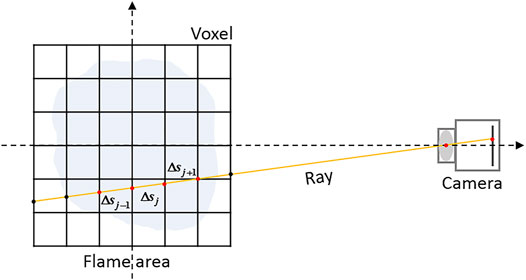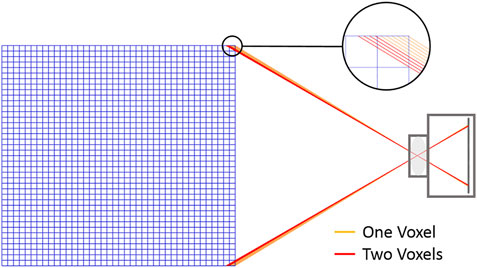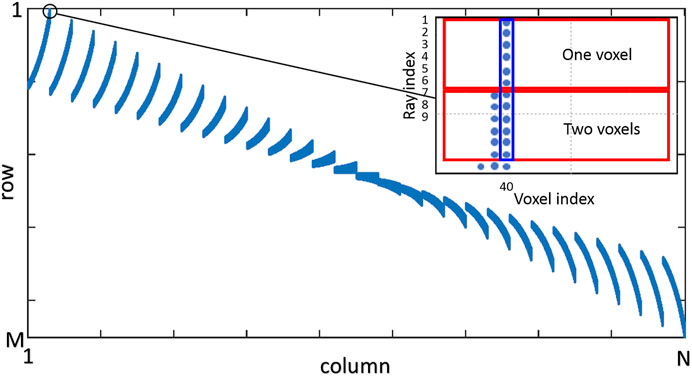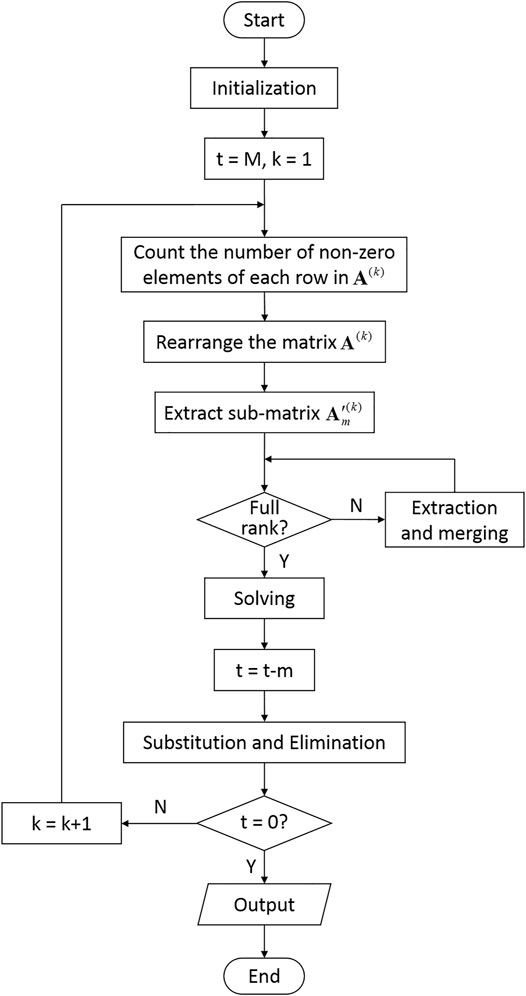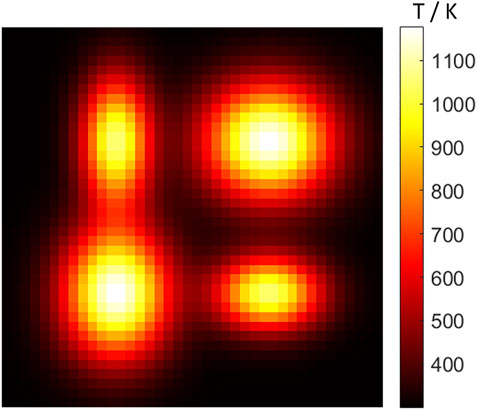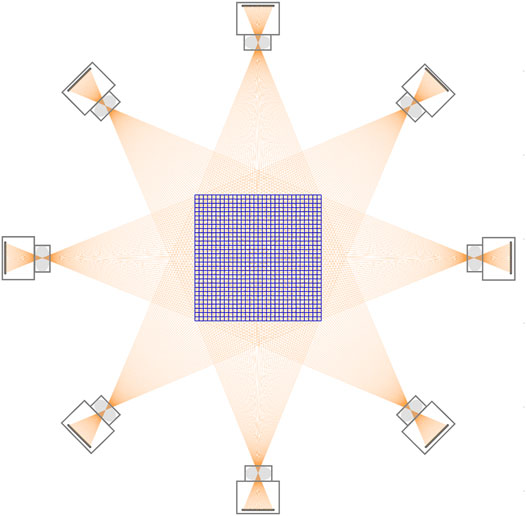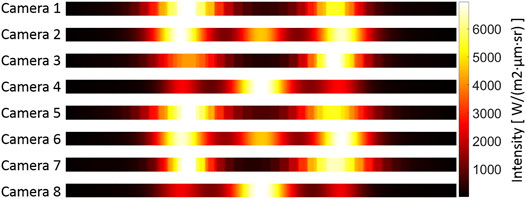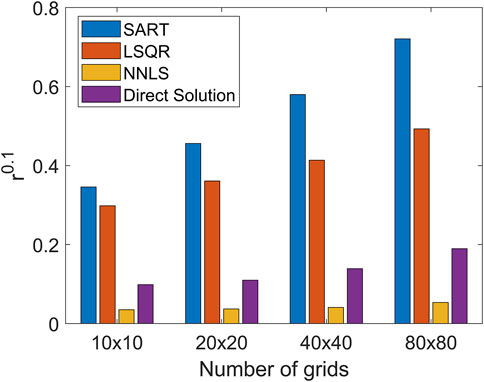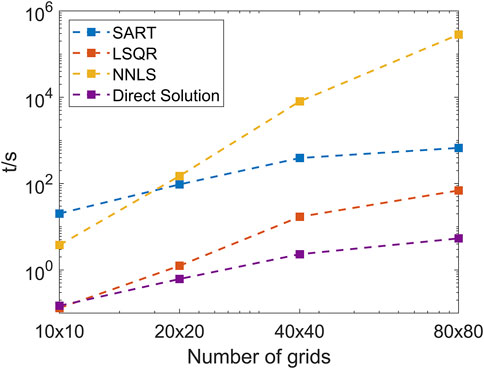- National Engineering Research Center of Turbo-Generator Vibration, School of Energy and Environment, Southeast University, Nanjing, China
The rapid and accurate measurement of the flame temperature distribution is of great significance to the structural design and health diagnosis of the engine. Aiming at the low reconstruction efficiency of traditional flame temperature distribution reconstruction algorithms, a Direct Solution algorithm for flame temperature distribution reconstruction is proposed in this paper based on the structural characteristics of the reconstruction equations. By setting several numerical cases, the performance of the Direct Solution algorithm and some commonly used traditional algorithms, such as Simultaneous Algebraic Reconstruction Technique (SART), Least Squares QR-factorization (LSQR) algorithm, Non-Negative Least Squares QR-factorization (NNLS) algorithm, is compared in the reconstruction of the flame temperature distribution. The results show that the efficiency of the Direct Solution method is 169.4, 7.4, and 3483.3 times higher than that of the SART, LSQR, and NNLS algorithms under the condition of 40 × 40 grids. In addition, with the increase of the number of grids, the growth rate of the reconstruction time of the Direct Solution algorithm is much lower than that of other algorithms. The overall reconstruction accuracy of the Direct Solution algorithm is better than that of SART and LSQR algorithms. This shows that it has an excellent comprehensive performance and has a great application prospect in the rapid reconstruction of the temperature distribution.
Introduction
Thrust-to-weight ratio is a comprehensive index to measure the performance level and working ability of aero engines. One of the main ways to improve the thrust-to-weight ratio of modern aero engines is to increase the outlet temperature of the combustion chamber (Zhang et al., 2019). As the temperature rises, turbine blades and vanes need to bear a greater thermal load. The huge thermal gradient causes severe thermal stress and strain on the blades, which greatly reduces the creep life of the blades, and leads to ablation, fracture and failure of the blades (Marahleh et al., 2006). Real-time monitoring and obtaining accurate combustion chamber outlet temperature can respond to local temperature sudden changes in the engine in a timely manner, which is of great significance for the safety of aero-engine operation and prolonged service life (Li et al., 2006; He et al., 2019; Gamil et al., 2020).
Due to the shortcomings of thermocouple and other contact temperature measurement, such as slow dynamic response, interference with combustion field, narrow temperature measurement range, only point measurement, high-temperature oxidation, etc., it is not suitable for cutting-edge combustion chambers under high temperature, high pressure, and high-speed conditions (Yang et al., 2015; Jenkins et al., 2020; Zhang et al., 2016; Lian et al., 2017). In recent years, the flame temperature distribution reconstruction technology based on radiation images has received extensive attention from researchers all over the world (Neuer et al., 2001; Sun et al., 2018; Qi et al., 2019; Zhao et al., 2017; Hossain et al., 2013; Niu et al., 2015). It has the advantages of non-invasiveness and no need for external excitation sources and is more suitable for the measurement of the exit temperature distribution of the combustion chamber of aero engines.
The radiation image method for temperature measurement utilizes flame radiation information from different directions to reconstruct the flame temperature field, and the use of a reasonable reconstruction algorithm is beneficial to improve the efficiency and accuracy of temperature distribution reconstruction. Generally, the number of grids in the reconstruction area will affect the efficiency of the reconstruction algorithm. As the number of grids increases, the difficulty and time to solve the ill-conditioned equations transformed from the inverse radiation problem tend to increase exponentially, which is difficult to meet the current demand for rapid reconstruction of the exit temperature of the combustion chamber of aero engines.
To solve the above-mentioned problems, Zhou et al. (2002) used an improved Tikhonov regularization algorithm to reconstruct a three-dimensional temperature distribution of
In this paper, based on the CCD camera imaging and flame radiative transfer model, the rapid reconstruction method of absorbing and scattering flame temperature distribution is carried out. It takes the generalized source term finite volume method as the model of the forward problem and the proposed direct solution algorithm as the inverse method for reconstructing the temperature distribution. Two numerical cases of flame temperature distribution reconstruction are designed to illustrate the performance of the proposed direct solution algorithm compared with the current main tomographic algorithms, such as Simultaneous Algebraic Reconstruction Technique (SART), LSQR, and Non-Negative Least Squares QR-factorization (NNLS) algorithm.
Theories and Methods
Forward Model
In the radiation image method for temperature measurement, as shown in Figure 1, an ideal thin lens model can be used to describe the imaging process of light from the object space passing through the lens to the camera detector pixels. The light entering the camera is characterized by the line between the center of the CCD pixel and the optical center of the lens. Considering that the flame is a semi-transparent object, the light will pass through the flame. When the deflection effect of the flame refractive index gradient on the light is not considered, the radiation of the flame voxel through which the light passes all contributes to the gray value of the pixel. Therefore, it is necessary to record the number of flame voxels that each detection light passes through, and the distance traveled in the voxel. According to the generalized source term finite volume method (Zhang et al., 2017), the radiation energy received on each pixel can be calculated by the following formula:
where
Since the propagation speed of light is much greater than the equilibrium speed of temperature, the radiative transfer of flame in radiation image method for temperature measurement can be expressed by the steady-state radiative transfer equation (Qi et al., 2015):
where
The second and third terms on the right side of Eq. (2) represent emission-enhanced and scattering-enhanced terms, respectively. The sum of the second and third terms can be defined as the generalized source term.
Each detected light of the camera can establish as an equation using Eq. (1), then all detected light of the camera can form reconstruction equations. The generalized source term distribution can be obtained through the inversion calculation of the reconstruction equations. After substituting the generalized source term, the finite volume method can be used to calculate the black body radiative intensity of each flame voxel, and then the temperature of each flame voxel can be obtained by Planck’s law.
where
Inversion Principle
The dimension of the coefficient matrix
According to Eq. (1), if the light passes through the flame voxel, the elements in the corresponding coefficient matrix are non-zero. If non-zero elements of the coefficient matrix are represented by blue dots, and zero elements of the coefficient matrix are represented by blanks, the coefficient matrix can be represented as Figure 3. It can be seen that the coefficient matrix
Since the reconstruction method proposed in this paper is to solve a certain unknown parameter each time directly, this method is called Direct Solution algorithm. The procedure for implementing the Direct Solution algorithm is described as the following steps, and the flowchart is shown in Figure 4.
Step 1. Input the coefficient matrix
Step 2. According to the counted number of non-zero elements, arrange the row vectors of the coefficient matrix in ascending order to form a new coefficient matrix
Step 3. Extract the row vectors containing the least specific non-zero element
Step 4. Check whether the solving sub-matrix
Step 5. Extract the row vectors containing element
Step 6. Use the LSQR algorithm to solve the sub-matrix
Results and Discussions
Evaluation Criterion
In order to evaluate the performance of the Direct Solution algorithm proposed in this paper, several common traditional reconstruction algorithms of flame temperature distribution are selected for comparison, such as SART (Liu et al., 2017), LSQR (Liu et al., 2010), NNLS (Li et al., 2019) algorithms. In terms of reconstruction accuracy, the following criteria are used for evaluation (Resnick et al., 1985): 1) The normalized mean square distance,
where
The normalized average absolute distance
These traditional reconstruction algorithms have been widely used in the reconstruction of flame temperature distribution based on radiation imaging and have been proved to have high reconstruction accuracy. The processes of the temperature reconstruction in these above three algorithms are similar to that of the direct solution algorithm. And the specific principles and steps are also commonly found in other references (Andersen et al., 1984; Teng et al., 1989; Bombara et al., 2011). Thus, this paper will not repeat them here.
Camera and Flame Settings
There is a four-peak 2D flame with a size of
where
Eight linear CCD cameras are arranged on the circle 0.55 m from the flame center. As shown in Figure 6, each camera focuses on the plane passing through the flame center. A lens with a magnification ratio of 1:3 is selected. The number of pixels of each camera is 4,096, and the pixel size is 7.04 µm
Performance Comparison
According to the arrangement of the camera system and the flame, the flame image of each camera, as shown in Figure 7, is obtained through the calculation of the radiative transfer equation and the reverse tracing of the light. The light that does not pass through any flame voxel is removed to obtain the number of effective rays is 28,304. Thus the scale of the reconstruction coefficient matrix is 28,304
The case was implemented using MATLAB code, and the developed program was executed on an Intel(R) Core(TM) i9-10940X CPU @ 3.30 GHz PC. The temperature distribution of the above-mentioned four-peak flame is reconstructed according to the measured flame image using SART, LSQR, NNLS, and Direct Solution algorithm, respectively. The calculation efficiency and accuracy results are shown in Table 1. It can be seen from the table that the reconstruction accuracy of the Direct Solution algorithm is better than the SART and LSQR algorithms and slightly worse than that of the NNLS algorithm in the three reconstruction quality evaluation indicators. This is because the Direct Solution algorithm uses the LSQR algorithm to calculate the small-scale equations, and the NNLS algorithm performs non-negative constraints on the calculation results based on the physical characteristics of the flame so that the method can avoid some local optimal solution that do not conform to the laws of physics.
In terms of reconstruction efficiency, the Direct Solution algorithm is 169.4 times higher than the SART algorithm, 7.4 times higher than the LSQR algorithm, and 3483.3 times higher than the NNLS algorithm, which has obvious advantages. This is because the Direct Solution algorithm gradually decomposes the equation system into multiple sub-equation systems and solves them one by one. Each sub-equation system has a few unknowns to solve, avoiding the direct calculation of large-scale equations, which can greatly reduce the calculating time.
Influence of the Grids Number
The size and temperature of the flame area are kept unchanged, and the discrete grids of the flame area is set as 10 × 10, 20 × 20, 40 × 40, and 80 × 80, as shown in Figure 8. In this case, all the camera and lens parameters are kept unchanged. The total number of the detected light is 32,768. After ray tracing, the rays that do not pass through any flame control body are eliminated, and the number of effective rays under the four grids is 28,304.
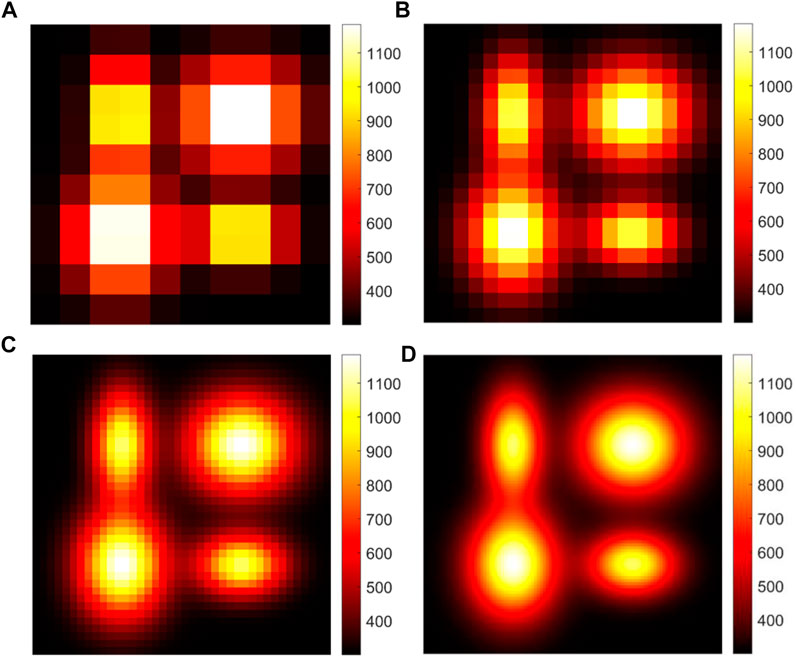
FIGURE 8. The temperature distribution under different grids (A) 10 × 10, (B) 20 × 20, (C) 40 × 40, and (D) 80 × 80.
The flame temperature distribution is reconstructed using the SART algorithm, LSQR algorithm, NNLS algorithm, and Direct Solution algorithm proposed in this paper, and the overall error distribution and calculation time change of the four algorithms under different grids are obtained. The accuracy and efficiency of these algorithms are shown in Figure 9 and Figure 10. It can be seen from the figure that as the number of grids increases, the scale of the equation system expands, and the error presents an upward trend. The reconstruction accuracy of the Direct Solution algorithm is less than that of the NNLS algorithm but better than the SART and LSQR algorithms.
It can be seen from Figure 10 that as the number of grids gradually increases, the calculation time of the four algorithms increases. The calculation time of the Direct Solution algorithm increases slowest, indicating that it is least affected by the increase in the scale of the equations. The direct solution algorithm takes less time than the other three algorithms, indicating that when the number of grids increases, the direct solution algorithm takes less time to extract and solve the partial extraction of the overall equation system. This reduces the overall time-consuming to solve all the unknowns, greatly shortens the reconstruction time compared to other algorithms. The above numerical results show that the Direct Solution algorithm can quickly reconstruct the flame temperature distribution under the premise of ensuring accuracy. In occasions where real-time reconstruction is required, this algorithm has greater application prospects.
Conclusion
In this paper, a Direct Solution algorithm is proposed. It can quickly reconstruct the flame temperature distribution. According to the characteristics of the reconstruction coefficient matrix, it first performs statistical classification according to the minimum non-zero element criterion and the full rank criterion of the sub-equation system. And then, it solves the small-scale equations group by group according to the method of “solving-substitution”, which greatly improves the reconstruction efficiency of large-scale sparse equations. The performance of the proposed method is compared with that of the traditional tomographic reconstruction algorithms. Under the condition of 40 × 40 grids, the normalized average absolute distance criterion r, normalized mean square distance criterion q, and worst-case distance criterion e of the proposed algorithm are all smaller than that of SART and LSQR algorithms. Compared with the SART, LSQR, and NNLS algorithms, the reconstruction efficiency is increased by 169.4, 7.4, and 3483.3 times, respectively. On this basis, the influence of the grids number on the reconstruction algorithm is analyzed. The results show that as the number of grids increases, the reconstruction time of the Direct Solution algorithm increases the slowest. The overall reconstruction accuracy is higher than SART and LSQR methods, which can meet the accuracy requirements on many occasions.
Data Availability Statement
The original contributions presented in the study are included in the article/supplementary material, further inquiries can be directed to the corresponding authors.
Author Contributions
BZ: conceptualization, writing - original draft, and methodology. W-JP: coding and data processing. JL: Investigation and Visualization. Z-HL: writing editing. C-LX: paper reviewing and supervision. All authors contributed to the article and approved the submitted version.
Funding
The supports of this work by the National Natural Science Foundation of China (No. 52176167, 52006036), and the Natural Science Foundation of Jiangsu Province (No. BK20201279, BK20190366) are gratefully acknowledged.
Conflict of Interest
The authors declare that the research was conducted in the absence of any commercial or financial relationships that could be construed as a potential conflict of interest.
Publisher’s Note
All claims expressed in this article are solely those of the authors and do not necessarily represent those of their affiliated organizations, or those of the publisher, the editors and the reviewers. Any product that may be evaluated in this article, or claim that may be made by its manufacturer, is not guaranteed or endorsed by the publisher.
References
Andersen, A. H., and Kak, A. C. (1984). Simultaneous Algebraic Reconstruction Technique (SART): a superior Implementation of the ART Algorithm. Ultrason. Imaging 6 (1), 81–94. doi:10.1016/0161-7346(84)90008-7
Bombara, G., Cococcioni, M., Lazzerini, B., and Marcelloni, F. (2011). S-NNLS: An Efficient Non-negative Least Squares Algorithm for Sequential Data. Int. J. Numer. Meth. Biomed. Engng. 27 (5), 770–773. doi:10.1002/cnm.1331
Cai, W., Li, X., Li, F., and Ma, L. (20132013). Numerical and Experimental Validation of a Three-Dimensional Combustion Diagnostic Based on Tomographic Chemiluminescence. Opt. Express 21 (6), 7050–7064. doi:10.1364/OE.21.007050
Gamil, A. A. A., Nikolaidis, T., Lelaj, I., and Laskaridis, P. (2020). Assessment of Numerical Radiation Models on the Heat Transfer of an Aero-Engine Combustion Chamber. Case Stud. Therm. Eng. 22, 100772. doi:10.1016/j.csite.2020.100772
He, L., Chen, Y., Deng, J., Lei, J., Fei, L., and Liu, P. (2019). Experimental Study of Rotating Gliding Arc Discharge Plasma-Assisted Combustion in an Aero-Engine Combustion Chamber. Chin. J. Aeronautics 32 (2), 337–346. doi:10.1016/j.cja.2018.12.014
Hossain, M. M., Lu, G., Sun, D., and Yan, Y. (2013). Three-dimensional Reconstruction of Flame Temperature and Emissivity Distribution Using Optical Tomographic and Two-Colour Pyrometric Techniques. Meas. Sci. Technol. 24 (7), 074010. doi:10.1088/0957-0233/24/7/074010
Huang, X., Qi, H., Zhang, X.-L., Ren, Y.-T., Ruan, L.-M., and Tan, H.-P. (2018). Application of Landweber Method for Three-Dimensional Temperature Field Reconstruction Based on the Light-Field Imaging Technique. J. Heat Trans. –T. ASME 140, 082701–082711. doi:10.1115/1.4039305
Jenkins, T. P., Hess, C. F., Allison, S. W., and Eldridge, J. I. (2020). Measurements of Turbine Blade Temperature in an Operating Aero Engine Using Thermographic Phosphors. Meas. Sci. Technol. 31 (4), 044003. doi:10.1088/1361-6501/ab4c20
Li, J., Hossain, M. M., Sun, J., Liu, Y., Zhang, B., Tachtatzis, C., et al. (2019). Simultaneous Measurement of Flame Temperature and Absorption Coefficient through LMBC-NNLS and Plenoptic Imaging Techniques. Appl. Therm. Eng. 154, 711–725. doi:10.1016/j.applthermaleng.2019.03.130
Li, L., Peng, X. F., and Liu, T. (2006). Combustion and Cooling Performance in an Aero-Engine Annular Combustor. Appl. Therm. Eng. 26 (16), 1771–1779. doi:10.1016/j.applthermaleng.2005.11.023
Lian, W., and Xuan, Y. (2017). Experimental Investigation on a Novel Aero-Engine Nose Cone Anti-icing System. Appl. Therm. Eng. 121, 1011–1021. doi:10.1016/j.applthermaleng.2017.04.160
Liu, D., Yan, J. H., Wang, F., Huang, Q. X., Chi, Y., and Cen, K. F. (2010). Inverse Radiation Analysis of Simultaneous Estimation of Temperature Field and Radiative Properties in a Two-Dimensional Participating Medium. Int. J. Heat Mass Transfer 53 (21-22), 4474–4481. doi:10.1016/j.ijheatmasstransfer.2010.06.046
Liu, S., Liu, S., and Ren, T. (2017). Acoustic Tomography Reconstruction Method for the Temperature Distribution Measurement. IEEE Trans. Instrum. Meas. 66 (8), 1936–1945. doi:10.1109/TIM.2017.2677638
Marahleh, G., Kheder, A. R. I., and Hamad, H. F. (2006). Creep-life Prediction of Service-Exposed Turbine Blades. Mater. Sci. 42 (4), 476–481. doi:10.1007/s11003-006-0103-8
Neuer, G., Fischer, J., Edler, F., and Thomas, R. (2001). Comparison of Temperature Measurement by Noise Thermometry and Radiation Thermometry. Measurement 30 (3), 211–221. doi:10.1016/S0263-2241(01)00006-9
Niu, C.-Y., Qi, H., Huang, X., RuanRuan, L.-M. L. M., Wang, W., and Tan, H.-P. (2015). Simultaneous Reconstruction of Temperature Distribution and Radiative Properties in Participating media Using a Hybrid LSQR-PSO Algorithm. Chin. Phys. B 24 (11), 114401. doi:10.1088/1674-1056/24/11/114401
Qi, H., Niu, C.-Y., Gong, S., Ren, Y.-T., and Ruan, L.-M. (2015). Application of the Hybrid Particle Swarm Optimization Algorithms for Simultaneous Estimation of Multi-Parameters in a Transient Conduction-Radiation Problem. Int. J. Heat Mass Transfer 83, 428–440. doi:10.1016/j.ijheatmasstransfer.2014.12.022
Qi, Q., Hossain, M. M., Zhang, B., Ling, T., and Xu, C. (2019). Flame Temperature Reconstruction through a Multi-Plenoptic Camera Technique. Meas. Sci. Technol. 30 (12), 124002. doi:10.1088/1361-6501/ab2e98
Qiu, S., Lou, C., and Xu, D. (2014). A Hybrid Method for Reconstructing Temperature Distributions in a Radiant Enclosure. Numer. Heat Transfer, A: Appl. 66 (10), 1097–1111. doi:10.1080/10407782.2014.901034
Resnick, J. (1985). The Radon Transforms and Some of its Applications. IEEE Trans. Acoust. Speech, Signal. Process. 33 (1), 338–339. doi:10.1109/TASSP.1985.1164533
Sun, J., Hossain, M. M., Xu, C., and Zhang, B. (2018). Investigation of Flame Radiation Sampling and Temperature Measurement through Light Field Camera. Int. J. Heat Mass Transfer 121, 1281–1296. doi:10.1016/j.ijheatmasstransfer.2018.01.083
Teng, K. F., and Ping Wu, P. (1989). PV Module Characterization Using Q-R Decomposition Based on the Least Square Method. IEEE Trans. Ind. Electron. 36 (1), 71–75. doi:10.1109/41.20347
Yang, L., and Zhi-min, L. (2015). The Research of Temperature Indicating Paints and its Application in Aero-Engine Temperature Measurement. Proced. Eng. 99, 1152–1157. doi:10.1016/j.proeng.2014.12.697
Zhang, B., Xu, C.-L., and Wang, S.-M. (2017). Generalized Source Finite Volume Method for Radiative Transfer Equation in Participating media. J. Quantitative Spectrosc. Radiative Transfer 189, 189–197. doi:10.1016/j.jqsrt.2016.11.025
Zhang, B., Xu, C. L., and Wang, S. M. (2016). An Inverse Method for Flue Gas Shielded Metal Surface Temperature Measurement Based on Infrared Radiation. Meas. Sci. Technol. 27 (7), 074002. doi:10.1088/0957-0233/27/7/074002
Zhang, R. C., Huang, X. Y., Fan, W. J., and Bai, N. J. (2019). Influence of Injection Mode on the Combustion Characteristics of Slight Temperature Rise Combustion in Gas Turbine Combustor with Cavity. Energy 179 (15), 603–617. doi:10.1016/j.energy.2019.04.223
Zhao, W., Zhang, B., Xu, C., Duan, L., and Wang, S. (2018). Optical Sectioning Tomographic Reconstruction of Three-Dimensional Flame Temperature Distribution Using Single Light Field Camera. IEEE Sensors J. 18 (2), 528–539. doi:10.1109/JSEN.2017.2772899
Zhou, H.-C., Han, S.-D., Sheng, F., and Zheng, C.-G. (2002). Visualization of Three-Dimensional Temperature Distributions in a Large-Scale Furnace via Regularized Reconstruction from Radiative Energy Images: Numerical Studies. J. Quantitative Spectrosc. Radiative Transfer 72 (4), 361–383. doi:10.1016/S0022-4073(01)00130-3
Keywords: radiation imaging, tomographic reconstruction, flame temperature measurement, rapid reconstruction, direct solution algorithm
Citation: Zhang B, Peng W-J, Li J, Li Z-H and Xu C-L (2021) A Fast Tomographic Reconstruction Method for Flame Temperature Distribution Measurement Based on Direct Solution Algorithm. Front. Energy Res. 9:790581. doi: 10.3389/fenrg.2021.790581
Received: 07 October 2021; Accepted: 13 October 2021;
Published: 02 November 2021.
Edited by:
Xiangdong Liu, YangzhouUniversity,ChinaReviewed by:
Linyang Wei, Northeastern University, ChinaYatao Ren, Harbin Institute of Technology, China
Copyright © 2021 Zhang, Peng, Li, Li and Xu. This is an open-access article distributed under the terms of the Creative Commons Attribution License (CC BY). The use, distribution or reproduction in other forums is permitted, provided the original author(s) and the copyright owner(s) are credited and that the original publication in this journal is cited, in accordance with accepted academic practice. No use, distribution or reproduction is permitted which does not comply with these terms.
*Correspondence: Jian Li, ZWVsaWppYW5Ac2V1LmVkdS5jbg==; Chuan-Long Xu, Y2h1YW5sb25neHVAc2V1LmVkdS5jbg==
 Biao Zhang
Biao Zhang Wei-Jian Peng
Wei-Jian Peng Jian Li*
Jian Li*